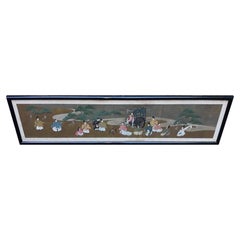Japanese Horizontal Art
to
1
1
1
1
Sort By
Large Antique Horizontal Japanese Painting
Located in Lambertville, NJ
An antique horizontal Japanese Meiji period qouache watercolor painting with black lacquered frame
Category
Antique 1880s Japanese Meiji Paintings and Screens
Materials
Glass, Hardwood, Paper
Get Updated with New Arrivals
Save "Japanese Horizontal Art", and we’ll notify you when there are new listings in this category.
Japanese Horizontal Art For Sale on 1stDibs
With a vast inventory of beautiful furniture at 1stDibs, we’ve got just the piece of Japanese horizontal art you’re looking for. Was constructed with extraordinary care, often using fabric, wood and silk. There are 56 variations of the antique or vintage item from our selection of Japanese horizontal art you’re looking for, while we also have 38 modern editions of this piece to choose from as well. There are many kinds of the choice in our collection of Japanese horizontal art you’re looking for, from those produced as long ago as the 18th Century to those made as recently as the 21st Century. An object in our assortment of Japanese horizontal art, designed in the mid-century modern, Scandinavian Modern or modern style, is generally a popular piece of furniture. Many designers have produced at least one well-made option in this array of Japanese horizontal art over the years, but those crafted by Finn Juhl, Kvadrat and Raf Simons are often thought to be among the most beautiful.
How Much is a Japanese Horizontal Art?
Prices for a piece of Japanese horizontal art can differ depending upon size, time period and other attributes — at 1stDibs, they begin at $99 and can go as high as $165,000, while the average can fetch as much as $2,349.
Questions About Japanese Horizontal Art
- 1stDibs ExpertApril 5, 2022The writing on Japanese art is calligraphy art called shodo. It uses Japanese kanji and kana characters. There are a variety of different shodo styles of art, including Kaisho, which is the basic, foundational form of the art. On 1stDibs, find a range of Japanese calligraphy art from top sellers..
- 1stDibs ExpertApril 16, 2024The focus of Japanese art varies. Many traditional Japanese artists sought to capture the beauty of nature in their works. However, other Japanese artists have produced work with Buddhist themes, and contemporary artists working in the country have been inspired by a range of subjects, from socioeconomic and political issues to pop culture. On 1stDibs, explore a large selection of Japanese art.
- 1stDibs ExpertApril 5, 2022There are a variety of different types of Japanese art. One of the oldest and most admired forms of Japanese art is the art of calligraphy, which originated in the sixth or seventh century. Another type of art, ukiyo-e, is the art of the woodblock print, which depicts scenes of female beauties; kabuki actors, sumo wrestlers and more. You’ll find a variety of Japanese artwork from some of the world’s top art dealers on 1stDibs.
- 1stDibs ExpertApril 5, 2022Many art styles originated in Japan and grew in popularity over the years. Some of the most popular styles include shodo (calligraphy), ikebana, kanou and yamato-e. You’ll find a wide variety of authentic Japanese art from some of the world’s top dealers on 1stDibs.
- 1stDibs ExpertApril 5, 2022What Japanese wall art is called depends on its type. There are numerous kinds of Japanese paintings and prints, including nihonga and ukiyo-e. A Japanese wall scroll is known as a kakejiku or kakemono. On 1stDibs, find a variety of Japanese wall art.
- 1stDibs ExpertSeptember 23, 2024What the Japanese sea art is called depends on its type. Many examples of sea art from Japan are called ukiyo-e. This term refers to woodblock prints made during the 17th, 18th and 19th centuries. The Great Wave off Kanagawa by Katsushika Hokusai is arguably the most famous ukiyo-e print depicting the sea. On 1stDibs, find a wide variety of Japanese woodblock prints.
- 1stDibs ExpertOctober 15, 2024To tell if art is Japanese or Chinese, study the piece's characteristics. With paintings, Chinese artists often use more color and tend to fill their entire canvases, while Japanese artists often include more negative space and choose subtler colors. There are also differences between the brushstrokes typical of traditional Chinese and Japanese art. In Japanese paintings, brushstrokes are often short and sharp. On the other hand, Chinese paintings often display longer, more fluid brushstrokes. Learning about the defining features of various art forms and periods and looking at examples of pieces made by Japanese and Chinese artists can help you learn to spot subtle differences. Explore a diverse assortment of Japanese and Chinese art on 1stDibs.
